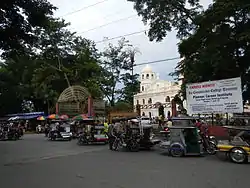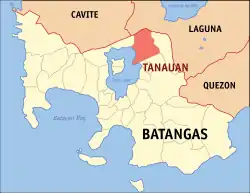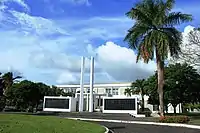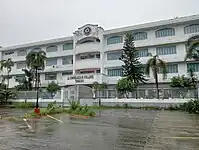Tanauan
Tanawan | |
|---|---|
| City of Tanauan | |
 F. Laurena Street in Tanauan | |
 Flag  Seal | |
| Nickname(s): Cradle of Noble Heroes The City of Colors"Premiere City of CALABARZON" | |
| Anthem: Himno ng Tanauan, Tanauan Bayan Ko [1][2] English: Tanauan Hymn, Tanauan My Town | |
 Map of Batangas with Tanauan highlighted | |
OpenStreetMap | |
.svg.png.webp) Tanauan Location within the Philippines, Captaincy General of the Philippines | |
| Coordinates: 14°05′N 121°09′E / 14.08°N 121.15°E | |
| Country | Philippines |
| Region | Calabarzon |
| Province | Batangas |
| District | 3rd district |
| Founded | 1572 |
| Cityhood | March 10, 2001 |
| Founded by | Augustinians |
| Barangays | 48 (see Barangays) |
| Government | |
| • Type | Sangguniang Panlungsod |
| • Mayor | Nelson P. Collantes |
| • Vice Mayor | Herminigildo G. Trinidad, Jr. |
| • Representative | Ma. Theresa V. Collantes |
| • City Council | Members |
| • Electorate | 134,905 voters (2022) |
| Area | |
| • Total | 107.16 km2 (41.37 sq mi) |
| Elevation | 168 m (551 ft) |
| Highest elevation | 1,094 m (3,589 ft) |
| Lowest elevation | 5 m (16 ft) |
| Population (2020 census)[5] | |
| • Total | 193,936 |
| • Density | 1,800/km2 (4,700/sq mi) |
| • Households | 46,680 |
| Demonym(s) | Tanaueño (masculine) Tanaueña (feminine) |
| Economy | |
| • Income class | 1st city income class |
| • Poverty incidence | 8.74 |
| • Revenue | ₱ 1,901 million (2020) |
| • Assets | ₱ 5,433 million (2020) |
| • Expenditure | ₱ 1,486 million (2020) |
| • Liabilities | ₱ 1,035 million (2020) |
| Service provider | |
| • Electricity | Batangas 2 Electric Cooperative (BATELEC 2) |
| • Water | MWPV South Luzon Water Corporation[7] |
| Time zone | UTC+8 (PST) |
| ZIP code | 4232 |
| PSGC | |
| IDD : area code | +63 (0)43 |
| Native languages | Tagalog |
| Numbered highways |
|
| Website | www |
Tanauan, officially the City of Tanauan (Filipino: Lungsod ng Tanauan), is a 1st class component city in the province of Batangas, Philippines. According to the 2020 census, it has a population of 193,936 people.[5]
It is incorporated as a city under Republic Act No. 9005, signed on February 2, 2001, and ratified on March 10, 2001.
The city is part of Mega Manila resulting from the continuous expansion of Metro Manila. It shares its borders with Calamba, Laguna, to the north, Tagaytay City, Cavite, to the northwest, Talisay to the west, Santo Tomas City to the east, and the towns of Balete and Malvar to the south. It borders on Taal Lake to the west. The town is known for the Old Tanauan Church Ruins, the most important archaeological site in the municipality where human remains from the colonial era have been unearthed.
Among those born in Tanauan are revolutionary former Prime Minister Apolinario Mabini and former President José P. Laurel.
Etymology
The name "Tanauan" may have come from:
- the Tagalog word tanaw, which means "to look through [the window]," as it was the site of a lookout tower that provides a view of the Pansipit River on the other side of Taal Lake and of the surrounding lands; or
- tanawa, a shrub that flourished in the area and on the shoreline of Taal Lake, according to the National Historical Commission of the Philippines.[8]
History

Tanauan was founded by the Augustinians in 1584 on the northwestern bay of Taal Lake (formerly Bombon Lake), called Tanauan Bay. Lookout towers were associated with 16th and 17th century churches to forewarn of Moro raids. "Old Tanauan" (Tagalog: Lumang Tanauan) included such lookout tower and associated sapao (built-up structures in the water). The 1754 eruption of Taal Volcano forced the town inhabitants to initially move to Sala. Then both towns moved again later that year to Tanauan's current location, in which Sala is now a barrio.[9]
Tanaueños have displayed characteristics of personal independence and nationalism since early history. The town is called the cradle of noble heroes due to its contribution to the revolutionary movement of its sons Apolinario Mabini, the brains of Katipunan, and later by the statesman José P. Laurel. Also, three Tanaueños served as governors of Batangas, namely: José P. Laurel V, Modesto Castillo and Nicolas Gonzales.[8]
From 1903 to 1906, during the American occupation, it was consolidated with the municipality of Talisay and became the seat of the municipal government.[10][11] In 1904, the barrios of Balaquilong (Balakilong), Bayuyungan, Binirayan (Berinayan), Bugaan, and San Gabriel were ceded to Taal by virtue of Act No. 1244;[12] these barrios would eventually be returned to Talisay and later form the present-day Laurel.[13]
Recent events include the assassination of its former mayor, Cesar V. Platon, by NPA rebels on May 7, 2001, as he was running for the governorship of Batangas. This happened in Tuy a few days before the election.[14][15] On July 2, 2018, then-mayor Antonio Halili, noted for public humiliation campaigns against criminals and drug pushers, was assassinated during the flag raising ceremony at the city hall.[16][17]
Cityhood
The Congress approved Batangas 3rd District Representative Jose Macario Laurel IV's bill and a Senate counterpart measure to convert the municipality of Tanauan into a city on December 19, 2000. Republic Act No. 9005, known as "The Charter of the City of Tanauan," was signed into law on February 2, 2001 by President Gloria Macapagal Arroyo.
On March 10, 2001, a Saturday, the charter was approved by a referendum in Tanauan that drew 8,890 or 16% of the 55,453 registered voters. Two ballots were either spoiled or blank. The "yes" had it over the "no" by a landslide, 7,026 to 1,961.
According to cityhood advocates, quoted in reports reaching Batangas on Sunday, the turnout, despite being two times better than previous conversion-to-city exercises, was still only 16%.[18]
Geography
It is situated 64 kilometers (40 mi) south of Manila and 41 kilometers (25 mi) north of Batangas City.
Climate
| Climate data for Tanauan | |||||||||||||
|---|---|---|---|---|---|---|---|---|---|---|---|---|---|
| Month | Jan | Feb | Mar | Apr | May | Jun | Jul | Aug | Sep | Oct | Nov | Dec | Year |
| Mean daily maximum °C (°F) | 28 (82) |
29 (84) |
31 (88) |
32 (90) |
31 (88) |
29 (84) |
28 (82) |
28 (82) |
28 (82) |
28 (82) |
28 (82) |
28 (82) |
29 (84) |
| Mean daily minimum °C (°F) | 19 (66) |
19 (66) |
20 (68) |
21 (70) |
23 (73) |
24 (75) |
23 (73) |
23 (73) |
23 (73) |
22 (72) |
21 (70) |
20 (68) |
22 (71) |
| Average precipitation mm (inches) | 11 (0.4) |
13 (0.5) |
14 (0.6) |
32 (1.3) |
101 (4.0) |
142 (5.6) |
208 (8.2) |
187 (7.4) |
175 (6.9) |
131 (5.2) |
68 (2.7) |
39 (1.5) |
1,121 (44.3) |
| Average rainy days | 5.2 | 5.0 | 7.4 | 11.5 | 19.8 | 23.5 | 27.0 | 25.9 | 25.2 | 23.2 | 15.5 | 8.3 | 197.5 |
| Source: Meteoblue[19] | |||||||||||||
Demographics
| Year | Pop. | ±% p.a. |
|---|---|---|
| 1903 | 18,263 | — |
| 1918 | 22,473 | +1.39% |
| 1939 | 26,186 | +0.73% |
| 1948 | 30,203 | +1.60% |
| 1960 | 44,975 | +3.37% |
| 1970 | 61,910 | +3.24% |
| 1975 | 66,703 | +1.51% |
| 1980 | 74,020 | +2.10% |
| 1990 | 92,754 | +2.28% |
| 1995 | 103,868 | +2.14% |
| 2000 | 117,539 | +2.69% |
| 2007 | 142,537 | +2.70% |
| 2010 | 152,393 | +2.46% |
| 2015 | 173,366 | +2.49% |
| 2020 | 193,936 | +2.23% |
| Source: Philippine Statistics Authority[20][21][22][23] | ||
Barangays
Tanauan City is politically subdivided into 48 barangays.[24] Each barangay consists of puroks and some have sitios.
| Barangay | Land Area (hectares) | Population (as of 2015) | District |
|---|---|---|---|
| Altura Bata | 164.64 | 1,409 | None |
| Altura Matanda | 100.97 | 724 | None |
| Altura South | 102.18 | 690 | None |
| Ambulong | 218.38 | 6,723 | La Playa de Tanauan |
| Bañadero | 189.28 | 4,538 | La Playa de Tanauan |
| Bagbag | 569.67 | 3,210 | None |
| Bagumbayan | 239.00 | 6,460 | None |
| Balele | 620.43 | 7,587 | None |
| Banjo East | 145.92 | 3,310 | None |
| Banjo Laurel (Banjo West) | 308.45 | 2,624 | None |
| Bilogbilog | 406.44 | 4,911 | None |
| Boot | 385.43 | 6,005 | La Playa de Tanauan |
| Cale | 366.04 | 3,658 | None |
| Darasa | 327.28 | 17,561 | None |
| Gonzales | 188.29 | 1,898 | La Playa de Tanauan |
| Hidalgo | 97.31 | 1,070 | None |
| Janopol Occidental | 245.10 | 2,793 | None |
| Janopol Oriental | 289.91 | 3,049 | None |
| Laurel | 269.19 | 1,502 | None |
| Luyos | 183.23 | 1,631 | None |
| Mabini | 183.13 | 2,465 | None |
| Malaking Pulo | 543.60 | 4,146 | None |
| Maria Paz | 295.56 | 2,715 | La Playa de Tanauan |
| Maugat | 222.69 | 2,107 | None |
| Montaña (Ik-ik) | 94.20 | 1,987 | None |
| Natatas | 374.79 | 6,105 | None |
| Pagaspas | 311.71 | 4,070 | None |
| Pantay Matanda | 257.56 | 4,797 | None |
| Pantay Bata | 310.66 | 2,464 | None |
| Barangay 1 | 19.98 | 2,139 | Poblacion |
| Barangay 2 | 17.04 | 1,414 | Poblacion |
| Barangay 3 | 41.38 | 4,863 | Poblacion |
| Barangay 4 | 32.87 | 4,822 | Poblacion |
| Barangay 5 | 8.71 | 1,432 | Poblacion |
| Barangay 6 | 20.36 | 3,998 | Poblacion |
| Barangay 7 | 36.53 | 5,302 | Poblacion |
| Sala | 216.89 | 2,112 | None |
| Sambat | 88.82 | 3,621 | None |
| San Jose | 127.29 | 1,114 | None |
| Santol (Doña Jacoba Garcia) | 104.03 | 536 | None |
| Santor | 318.85 | 4,686 | None |
| Sulpoc | 400.18 | 2,039 | None |
| Suplang | 229.57 | 1,438 | None |
| Talaga | 442.62 | 4,755 | None |
| Tinurik | 229.82 | 5,532 | None |
| Trapiche | 241.21 | 7,352 | None |
| Ulango | 290.00 | 2,445 | None |
| Wawa | 112.93 | 1,557 | La Playa de Tanauan |
Religion

Roman Catholicism is the most dominant and visible religion in Tanauan. St. John the Evangelist is its patron, and its main church is the St. John the Evangelist Parish. La Consolacion College Tanauan (formerly Our Lady of Fatima Academy, 1948), run by the Augustinian Sisters of Our Lady of Consolation, is the first Catholic school in the city. Other Catholic schools include Our Lady of Assumption Montessori School and Daughters of Mary Immaculate School (lay-operated). First Asia Institute is converting from a non-sectarian school to a Catholic (Christian) school.
Iglesia ni Cristo, Jehovah's Witnesses, Mormons (The Church of Jesus Christ of Latter-day Saints), Islam and other religious groups are also present in the city.
Economy
Tanauan is known as an agricultural trading center of Calabarzon. Agricultural products from Calabarzon and as far as the Mimaropa and Bicol regions are being sent here before it reaches Metro Manila public markets. Aside from being an important agricultural center, Tanauan is also one of the Philippines' major industrial centers nowadays hosting four industrial parks which is home to various multinational companies and tourism facilities.
| Name | Description |
|---|---|
| First Philippine Industrial Park | A 450-hectare industrial park owned by Lopez Group and Sumitomo Corporation located in Tanauan and Santo Tomas, Batangas. FPIP Tanauan is the location of various multinational companies such as Nestlé, Honda, Brother Printers, Canon Philippines, Shimano, B/E Aerospace, Philip Morris-Fortune Tobacco Corporation and many more. |
| First Industrial Township Incorporated | Formerly PhilTown Technology Center located in Barangay Pagaspas which is now owned by First Philippine Holdings of the Lopez Group of Companies. This is home to Uni-President Philippines, the manufacturer of Homi instant noodles and Nooda Crunch. |
| Dolores Industrial Park | An industrial park in the Tanauan-Malvar area. It is the location of Metro Manila Turf Club. |
| Data Land Industrial Park | An industrial park owned by Data Land Corporation. This hosts the precast manufacturing facility of the said company. |
| Tanauan City Zentrum | A multi-sectoral development by the Torres Group of Companies located at the center of the new Tanauan Central Business District. It is now the location of the new Tanauan City Hall, which was inaugurated last July 23, 2017. In front of the new city hall is the new Tanauan People's Park. Aside from government centers, TCZ will also hosts office towers, condominiums and commercial centers by 2019. |
| Tagaytay Highlands Tourism Economic Zone | a proposed expansion of Tagaytay Highlands Estate by Belle Corporation. |
Transportation
.jpg.webp)
Public transport
Jeepneys serve the city and the nearby municipalities and barangays. Tricycles provide transportation on the barangays. Buses connect the city with Metro Manila and Batangas City.
Roads
The Southern Tagalog Arterial Road passes at the central part of the city. The expressway connects the city with the rest of Batangas. Jose P. Laurel Highway connects the city to Santo Tomas and to the Pan-Philippine Highway on the north and with Malvar, Lipa, San Jose, and Batangas City to the south. Another highway links Tanauan with Talisay and Tagaytay. A 7.8-kilometer (4.8 mi) service road on both sides of STAR Tollway will connect the northeastern barangays of Tanauan to the southeastern barangays of the city [32]
Aside from the STAR Tollway, national roads like the Jose P. Laurel Highway (Route 4) and Tanauan–Talisay Road (Route 421) serves also the city. The city also maintains roads that connects the rural barangays of the city.
Education

Among the tertiary educational establishments in Tanauan is the First Asia Institute of Technology and Humanities, La Consolacion College, Christian College of Tanauan, Nova Schola, the STI Academic Center, the DMMC Institute of Health Sciences, and the Tanauan Institute. The Tanauan Institute is the oldest private education institution in the city having been established in 1924. The Sapphire International Aviation Academy which caters to aspiring aircraft pilots is also located within the city at the Barradas Airstrip.
There are 9 private and 16 public high schools, and 27 private and 44 public elementary schools. Those schools are overseen by the City Schools Division of Tanauan.[33]
Government
Local government
.jpg.webp)
The current seat of government of the city is the New Tanauan City Hall located at Laurel Hill in Barangay Natatas. Inaugurated in 2017, it succeeded the old municipal hall in Barangay 2 in the city proper.
Elected Officials
| Position | Name | Party | |
|---|---|---|---|
| City Mayor | Nelson 'Sonny' Collantes | NPC | |
| City Council Presiding Officer | |||
| City Vice Mayor | Herminigildo Trinidad Jr. | PDDS | |
| Elected City Council Members | |||
| Councilors | Sam Aquino Bengzon | Liberal | |
| Eugene Yson | PDDS | ||
| Glen Win Gonzales | PDDS | ||
| Dra. Marissa Tabing | PDDS | ||
| Herman de Sagun | PDDS | ||
| Czylene Marqueses | PDDS | ||
| Benedicto Corona | NPC | ||
| Angel Burgos | PDDS | ||
| Kristel Guelos-Ramilo | NPC | ||
| Eric Manglo | NPC | ||
| Ex-Officio City Council Member | |||
| ABC President | Precious Germaine Agojo | Nonpartisan | |
| SKFed President | Ephraigme Bilog | Nonpartisan | |
Heads of government
- Estanislao Gonzales (1870–1884)
- Jose B. Gonzales (1885–1886)
- Ruperto Laurel (1887–1888)
- Sixto Gonzales Castillo (1892–1898)
- Pedro M. Carandang (1899–1900)
- Juan Gonzales Suizo (1900–1902)
- Florentino Laurena (1902)
- Valentin Dimayuga (1902–1903)
- Florentino Collantes (1903–1904)
- Prospero Dimayuga (1904–1905)
- Pantaleon Gonzales (1905–1906)
- Francisco Oñate (1906–1907)
- Fulgencio Platon (1907–1908)
- Nicolas Gonzales Sr. (1908–1912)
- Crispin Garcia (1912–1916)
- George Collantes (1916–1922)
- Fulgencio Platon (1922–1925)
- Florentino Laurena (1925–1928)
- Antonio Dimayuga (1928–1937)
- Felix Ebron (1937)
- Alfredo Magpantay (1937–1942)
- Nicolas Gonzales (1942–1943)
- Jose M. Corona (1943–1945)
- George Collantes (1946–1951)
- Pedro B. Gonzales (1951–1967)
- Jaime Banjo Laurel (1968–1970)
- Sebastian Carandang (1970–1971)
- Francisco E. Lirio (1971–1980)
- Sotero Olfato (1980–1987)
- Pedro Tipa (1987–1988)
- Sotero Olfato (1988–1992)
- Antonio C. Halili (1992)
- Cesar V. Platon (1992–2001)
- Alfredo C. Corona (2001–2006)
- Sonia L. Torres-Aquino (2006–2013)
- Antonio C. Halili (2013–2018)
- Jhoanna Corona-Villamor (2018–2019)
- Mary Angeline Halili (2019–2022)
- Nelson "Sonny" Collantes (2022–present)
Notable personalities
- Antonio Halili (Former Mayor)
- Sonny Collantes (Mayor)
- Jose P. Laurel (Former President of the Philippines; Former Senator; Former Associate Justice of the Philippines; Founder, Lyceum of the Philippines – LPU Manila)
- Jose Laurel Jr. (Former Speaker of the House)
- Apolinario Mabini (The Great Paralytic)
- Salvador Laurel (Former Vice President of the Philippines)
- Sotero Laurel (Former Senator/Founder, Lyceum of the Philippines University Batangas & Laguna)
- Arsenio Laurel, 2-time Macao Grand Prix Champion
- Zanjoe Marudo (actor, ABS-CBN)
- Jade Lopez (actress, GMA)
- Renato Corona (Former Chief Justice, 2010–2012)
- El Gamma Penumbra
- Carlo Pagulayan (cartoonist, Marvel Heroes)
- Mary Angeline Halili, (daughter of late former mayor Antonio Halili, politician)
- Joshua Garcia (actor, ABS-CBN)
- Diane Querrer (TV Host and News Anchor, PTV)
- Ka Louie Tabing (veteran broadcaster, "Sa Kabukiran" on DZMM)
- Christian C. Javier, Arena Chess Grandmaster - 2018,[34] ICCF Correspondence Chess Expert - 2021, Correspondence Chess Master - 2022[35] FIDE International Chess Organizer - 2021, National Arbiter of the Phils. - 2012, FIDE National Arbiter of Phils. - 2013.
Gallery
 Apolinario Mabini Shrine
Apolinario Mabini Shrine.jpg.webp) Pres. Jose P. Laurel Memorial Shrine
Pres. Jose P. Laurel Memorial Shrine Plaza Mabini
Plaza Mabini La Consolacion College, Tanauan
La Consolacion College, Tanauan
References
- ↑ "Post-Activity Compliance Report". City of Tanauan. 2019. Retrieved April 19, 2023.
- ↑ Tanauan Bayan Ko (Himno ng Tanauan/Tanauan Hymn)/Official Hymn of Tanauan City Batangas, retrieved April 19, 2023
- ↑ City of Tanauan | (DILG)
- ↑ "2015 Census of Population, Report No. 3 – Population, Land Area, and Population Density" (PDF). Philippine Statistics Authority. Quezon City, Philippines. August 2016. ISSN 0117-1453. Archived (PDF) from the original on May 25, 2021. Retrieved July 16, 2021.
- 1 2 Census of Population (2020). "Region IV-A (Calabarzon)". Total Population by Province, City, Municipality and Barangay. Philippine Statistics Authority. Retrieved July 8, 2021.
- ↑ "PSA Releases the 2018 Municipal and City Level Poverty Estimates". Philippine Statistics Authority. December 15, 2021. Retrieved January 22, 2022.
- ↑ "Manila Water consortium signs Php 1.5 billion deal for Tanauan project". Retrieved February 6, 2019.
- 1 2 "A Brief History of our City". Tanauan City Government. Retrieved July 5, 2023.
- ↑ Hargrove, Thomas (1991). The Mysteries of Taal: A Philippine volcano and lake, her sea life and lost towns. Manila: Bookmark Publishing. pp. 13, 33–55. ISBN 9715690467.
- ↑ Act No. 708 (March 28, 1903), An Act Reducing Thirteen of the Municipalities in the Province of Batangas to Five, Senate of the Philippines Legislative Digital Resources, retrieved July 5, 2023
- ↑ Act No. 1514 (July 23, 1906), An Act Increasing the Number of Municipalities in the Province of Batangas From Fifteen to Sixteen, by Separating From Tanauan the Former Municipality of Talisay, Reconstituting the Latter as a Municipality, and Giving to Each the Territory Which It Comprised Prior to the Passage of Act Numbered Seven Hundred and Eight, Senate of the Philippines Legislative Digital Resources, retrieved July 5, 2023
- ↑ Act No. 1244 (October 7, 1904), An Act Annexing the Barrios of Bayuyungan, Bugaan, Balaquilong, San Gabriel, and Binirayan, Now a Part of the Municipality of Tanauan, Province of Batangas, to the Municipality of Taal, in the Same Province, Senate of the Philippines Legislative Digital Resources, retrieved July 5, 2023
- ↑ Republic Act No. 5689 (June 21, 1969), An Act Creating the Municipality of Laurel in the Province of Batangas, The Corpus Juris, retrieved July 3, 2023
- ↑ Ozaeta, Arnell; Alviar, Rene (January 14, 2002). "Cops zeroing in on 4 more Platon 'killers'". The Philippine Star. Retrieved April 19, 2020.
- ↑ Ozaeta, Arnell; Leuterio, Joe; Alviar, Rene (May 8, 2001). "Lakas governor candidate in Batangas gunned down". The Philippine Star. Retrieved April 18, 2020.
- ↑ Maricar Cinco (July 2, 2018). "Tanauan mayor dead after flag ceremony shooting". Philippine Daily Inquirer. Retrieved July 2, 2018.
- ↑ "'Walk of shame' mayor shot dead". ABS-CBN News. July 2, 2018. Retrieved July 2, 2018.
- ↑ "Batangan: Tanauan backs into cityhood; House panel okays "jueteng" bill; Laurel drops plan for Santo Tomas cityhood". www.geocities.ws. Retrieved July 2, 2018.
- ↑ "Tanauan: Average Temperatures and Rainfall". Meteoblue. Retrieved May 5, 2020.
- ↑ Census of Population (2015). "Region IV-A (Calabarzon)". Total Population by Province, City, Municipality and Barangay. Philippine Statistics Authority. Retrieved June 20, 2016.
- ↑ Census of Population and Housing (2010). "Region IV-A (Calabarzon)" (PDF). Total Population by Province, City, Municipality and Barangay. National Statistics Office. Retrieved June 29, 2016.
- ↑ Censuses of Population (1903–2007). "Region IV-A (Calabarzon)". Table 1. Population Enumerated in Various Censuses by Province/Highly Urbanized City: 1903 to 2007. National Statistics Office.
{{cite encyclopedia}}: CS1 maint: numeric names: authors list (link) - ↑ "Province of Batangas". Municipality Population Data. Local Water Utilities Administration Research Division. Retrieved December 17, 2016.
- ↑ "Barangays of Tanauan City, Tanauan City Website, Retrieved: 15 October 2011". tanauancity.gov.ph. Retrieved April 11, 2018.
- ↑ "Poverty incidence (PI):". Philippine Statistics Authority. Retrieved December 28, 2020.
- ↑ "Estimation of Local Poverty in the Philippines" (PDF). Philippine Statistics Authority. November 29, 2005.
- ↑ "2003 City and Municipal Level Poverty Estimates" (PDF). Philippine Statistics Authority. March 23, 2009.
- ↑ "City and Municipal Level Poverty Estimates; 2006 and 2009" (PDF). Philippine Statistics Authority. August 3, 2012.
- ↑ "2012 Municipal and City Level Poverty Estimates" (PDF). Philippine Statistics Authority. May 31, 2016.
- ↑ "Municipal and City Level Small Area Poverty Estimates; 2009, 2012 and 2015". Philippine Statistics Authority. July 10, 2019.
- ↑ "PSA Releases the 2018 Municipal and City Level Poverty Estimates". Philippine Statistics Authority. December 15, 2021. Retrieved January 22, 2022.
- ↑ Admin. "Service road sa STAR Tollway, bubuksan". www.tanauancity.gov.ph. Retrieved April 11, 2018.
- ↑ "DepEd Tanauan City". Retrieved October 21, 2023.
- ↑ "Christian C. Javier - FIDE Profile". International Chess Federation.
- ↑ "Christian C. Javier - ICCF Profile". International Correspondece Chess Federation.
.svg.png.webp)